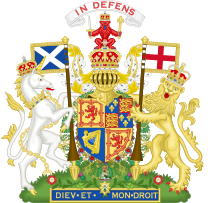Scots Army facts for kids
Quick facts for kids Scots ArmyScots Airmy |
|
|---|---|

|
|
| Active | 1660–1707 |
| Country | |
| Allegiance | Scottish monarchy |
| Colours | Blue and White |
| Engagements | |
| Commanders | |
| General-in-Chief |
See list
George Monck,
(1660–1670) James Scott, (1674–1679) John Churchill, (1690–1691) Meinhardt Schomberg, (1691) John Churchill (1702–1707) |
The Scots Army (in Scots: Scots Airmy) was the official army of the Kingdom of Scotland. It existed between 1660 and 1707. In 1660, the king returned to power in an event called the Restoration. In 1707, Scotland joined with England to form Great Britain through the Acts of Union.
At first, the Scots Army was a small group of soldiers. Their main job was to stop rebellions by groups like the Covenanters. These were Scottish Presbyterians who disagreed with the king's religious policies. The army also fought against a group called the Cameronians. Over time, the army grew bigger. By 1688, it had more than 3,500 soldiers. Many new groups of soldiers, called regiments, were formed. Some of these regiments fought in wars across Europe. The Scots Army first wore grey uniforms. But after 1684, they started wearing red, just like the English army.
Contents
How the Scots Army Started and Grew
Building a Standing Army (1660-1688)
After the king returned in 1660, Scotland's government decided to create a permanent army. This was different from calling up soldiers only when needed. This new army included groups of foot soldiers (infantry) and horse soldiers (cavalry). Some famous groups were the Life Guards and the Scots Guards. Another important group was Le Regiment de Douglas. This group had been serving in France since 1633. They returned to Scotland and became the Royal Regiment of Foot.
The army's main task was to put down uprisings. They often fought against the Covenanters, who were Scottish people fighting for their religious freedom. The army also had to deal with a type of fighting called guerrilla warfare. This was used by the Cameronians in eastern Scotland. In 1678, new groups of soldiers called "Dragoons" were formed. These were soldiers who rode horses but fought on foot. By 1681, they were known as the Royal Scots Greys because they rode grey horses. By 1688, the Scots Army had about 3,000 soldiers. It cost about £80,000 a year to run.
The Army After the Glorious Revolution (1688-1707)
In 1688, there was a big change in power called the Glorious Revolution. After this, ten new regiments were created to protect the new government. Some of these groups were later disbanded. But others fought against rebels in Scotland and in Ireland. They also played a big part in King William II's wars in Europe. These wars included the Nine Years' War (1689–1697) in Flanders.
The Scottish Parliament knew how important these soldiers were. In 1704, they made Queen Anne agree to a special law. They threatened to pull all Scottish soldiers out of the European wars if she didn't. By 1707, when Scotland and England united, the Scots Army had seven groups of foot soldiers, two groups of horse soldiers, and one group of Horse Guards. It also had cannons in castles like Edinburgh, Dumbarton, and Stirling. When the new British Army was formed, these Scottish regiments became part of it. Many of them had a long and proud history. New Scottish regiments, especially from the Highlands, were formed later, starting in the 1740s.
What Did Scots Army Soldiers Wear?
Uniforms and Colours
At first, the soldiers of the Scots Army probably wore clothes made from a plain, grey woollen cloth. This type of cloth was called "hodden grey." It had been used by soldiers in the 1640s during the Wars of the Three Kingdoms. The Dragoons, who were horse soldiers, continued to wear grey for a while.
However, after 1684, red cloth was brought in from England. This was used to make uniforms that looked like those of the English Army. Eventually, the Dragoons also started wearing red. It's possible that local militia groups, who were part-time soldiers, wore blue uniforms. Different regiments were identified by the colours on their collars and cuffs. These small details helped tell one group of soldiers from another.
Important Regiments of the Scots Army
Many different regiments were formed in the Scots Army between 1660 and 1707. Some of these groups had very long histories. They continued to serve in the British Army for many years after 1707. For example, the Royal Regiment of Scots Dragoons (also known as the Royal Scots Greys) and the Royal Regiment of Foot were very famous. The Scots Guards and the Royal Scots Fusiliers also had long and important roles. These regiments helped shape the history of the Scottish military.
Images for kids
See also


